A Computational Biomechanics Human Body Model Coupling Finite Element and Multibody Segments for Assessment of Head/Brain Injuries in Car-To-Pedestrian Collisions
Abstract
1. Introduction
- (a)
- Firstly, multibody dynamics analysis software (such as MADYMO [31]) is used to reconstruct the accident, then the boundary conditions (e.g., initial linear and angular velocity/acceleration, initial position, etc.) at the instant of head–vehicle contact are extracted and applied to the isolated FE head model (head-only) complemented by the FE vehicle subsystem model (such as windshield or bonnet) to obtain skull fracture and brain tissue injury data [32,33,34,35].
- (b)
- The accident is firstly reproduced with the full-scale MB models, similar to the above approach, and the time histories of the six degrees of freedom of the head center of gravity (COG) during the whole impact event are taken out from the MB reconstruction and prescribed to the head-only FE model to reproduce the brain tissue injury [36,37].
2. Materials and Methods
2.1. Development of CPCBM
2.1.1. Extraction of THUMS and TNO Pedestrian Models
Extraction of THUMS Pedestrian Model
Extraction of TNO Pedestrian Model
2.1.2. Coupling of Finite Element and Multibody Parts of the CPCBM
 ” in Figure 2a, including the upper torso and two clavicles) via the “Constraints MADYMO Body” keyword in the coupling assistant module in the MADYMO software package are created to implement the coupling of the FE head–neck complex with the remaining MB segments of the TNO pedestrian model. The coupling procedure is shown in Figure 2a, and the full-scale CPCBM is shown in Figure 2b.
” in Figure 2a, including the upper torso and two clavicles) via the “Constraints MADYMO Body” keyword in the coupling assistant module in the MADYMO software package are created to implement the coupling of the FE head–neck complex with the remaining MB segments of the TNO pedestrian model. The coupling procedure is shown in Figure 2a, and the full-scale CPCBM is shown in Figure 2b.2.2. Validation of the CPCBM
2.2.1. Description of Cadaver Tests
2.2.2. Modelling of the Impact Buck
2.2.3. Setting Up the Impact Simulation Between the Buck and PMHSs
Model Scaling and the Initial Posture Adjustment
Buck–Pedestrian Impact Modelling
2.2.4. Objective Rating Tool Correlation and Analysis (CORA)
3. Results
3.1. Comparison of Kinematic Response
3.2. Comparison of Injury Prediction
3.3. Calculation Efficiency of the Human Body Models
4. Discussion
4.1. Model Scaling and the Initial Posture Adjustment
4.2. Comparisons of the Dynamics Responses
4.3. Head Injury Prediction
4.4. Quantitative Evaluation Method CORA
4.5. Limitations
5. Conclusions
- (1)
- The comparative analysis and the correlation evaluation via the CORA method indicate that the CPCBM can reasonably predict the head center of gravity (COG) kinematics and injury response of the pedestrian due to car impact in the impact direction. The predicted trajectories in the impact direction (YOZ plane) strongly agree with the experimental results (CORA ratings: Y = 0.99 ± 0.01; Z = 0.98 ± 0.01); the resultant velocity relative to the impact buck correlates well with the test data (CORA ratings: 0.85 ± 0.05); however, the correlation of the acceleration is less strong (CORA ratings: 0.747 ± 0.06).
- (2)
- The CPCBM performed quite similarly to the full-scale TNO multibody pedestrian model in predicting the head COG kinematics and injury response of the tested subjects, which means the CPCBM carried over the pedestrian kinematics prediction performance of the TNO model that has been already widely verified, despite the replacement of the head–neck complex with the FE model.
- (3)
- Compared to the full-scale THUMS model, the CPCBM showed a remarkable advantage in the time efficiency of the scaling, posture adjustment, and impact simulation computation when used to calculate the pedestrian brain tissue level injury during a complex accident, which suggests that the CPCBM may serve as an efficient tool for pedestrian head/brain injury research due to car impact.
Author Contributions
Funding
Acknowledgments
Conflicts of Interest
Appendix A. Generic Sedan Buck Model


Appendix B. Still Captures



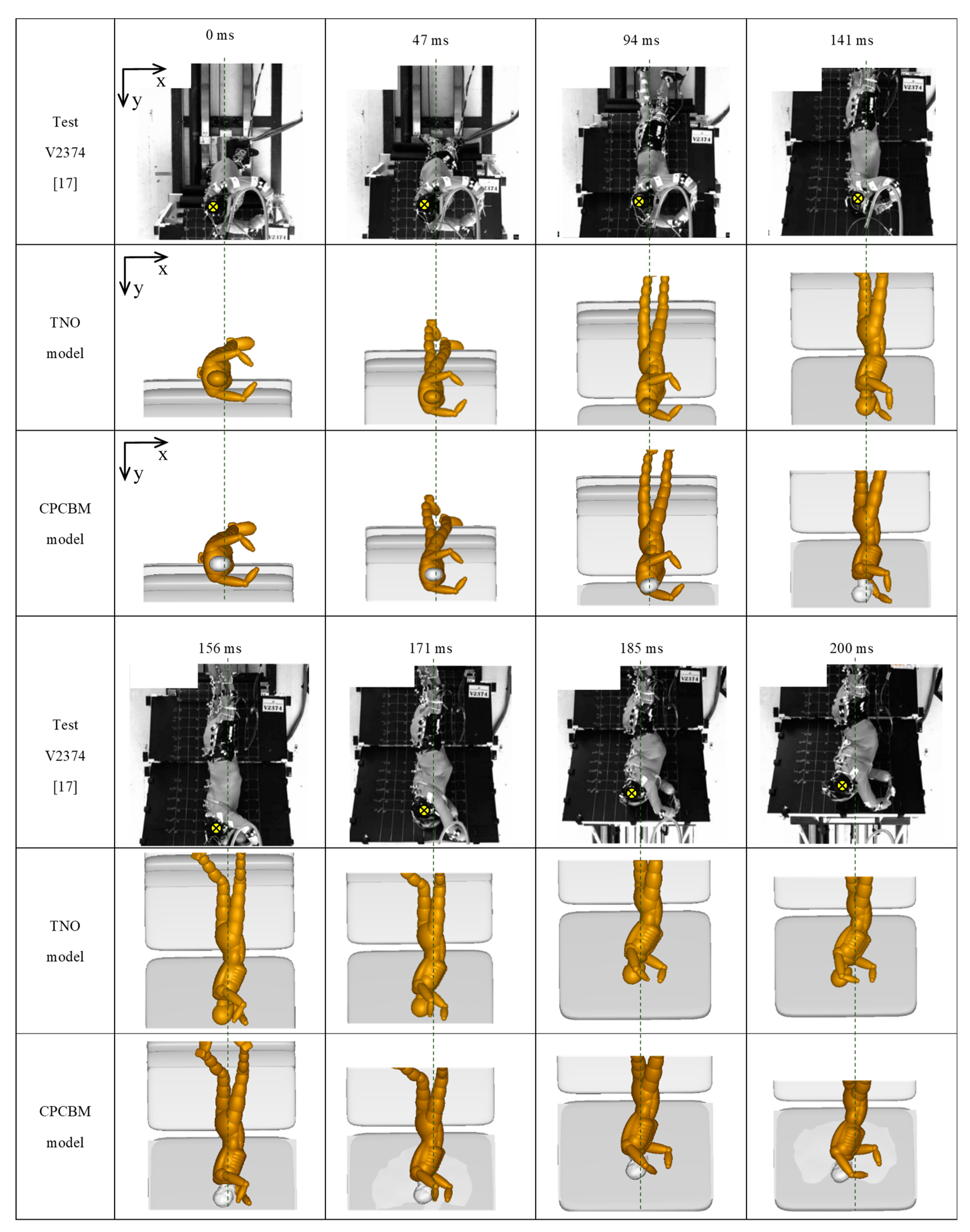
Appendix C. Trajectories, Displacement, Relative Resultant Velocity, Resultant Acceleration




Appendix D. The Comparison of Anthropometry Parameter
| Models | The THUMS Head-Neck Model | The TNO Head-Neck Model |
|---|---|---|
 |  | |
| Total mass | 5.66 kg | 6.21/6.39/6.3 kg |
| Moment of inertia of the Head-neck system model for test V2370 | Ixx = 1.5126 × 10−2 kg·m2 Iyy = 1.7991 × 10−2 kg·m2 Izz = 1.0557 × 10−2 kg·m2 | Ixx = 1.7090 × 10−2 kg·m2 Iyy = 1.8274 × 10−2 kg·m2 Izz = 1.3113 × 10−2 kg·m2 |
| Moment of inertia of the Head-neck system model for test V2371 | Ixx = 2.5004 × 10−2 kg·m2 Iyy = 2.8844 × 10−2 kg·m2 Izz = 1.7861 × 10−2 kg·m2 | |
| Moment of inertia of the Head-neck system model for test V2374 | Ixx = 2.1877 × 10−2 kg·m2 Iyy = 2.4686 × 10−2 kg·m2 Izz = 1.6003 × 10−2 kg·m2 |
Appendix E. CORA Data










References
- WHO. Global Status Report on Road Safety; World Health Organization: Geneva, Switzerland, 2015. [Google Scholar]
- Elliott, J.R.; Lyons, M.; Kerrigan, J.; Wood, D.; Simms, C. Predictive capabilities of the MADYMO multibody pedestrian model: Three-dimensional head translation and rotation, head impact time and head impact velocity. J. Multi Body Dyn. 2012, 226, 266–277. [Google Scholar] [CrossRef]
- TASS. MADYMO Human Body Models Manual Release 7.5; TASS: Helmand, The Netherlands, 2013; pp. 88–107. [Google Scholar]
- Watanabe, R.; Miyazaki, H.; Kitagawa, Y.; Yasuki, T. Research of collision speed dependency of pedestrian head and chest injuries using human FE model (THUMS Version 4). Accid. Reconstr. J. 2012, 22, 31–40. [Google Scholar]
- Shigeta, K.; Kitagawa, Y.; Yasuki, T. Development of next generation human FE model capable of organ injury prediction. In Proceedings of the 21st International Technical Conference on the Enhanced Safety of Vehicles (ESV), Stuttgart, Germany, 15–18 June 2009; National Highway Traffic Safety Administration: Stuttgart, Germany, 2009. [Google Scholar]
- Hoof, J.V.; Lange, R.D.; Wismans, J.S. Improving pedestrian safety using numerical human models. Stapp Car Crash J. 2003, 47, 401–436. [Google Scholar] [PubMed]
- Yang, J.K.; Lovsund, P.; Cavallero, C.; Bonnoit, J. A Human-Body 3D Mathematical Model for Simulation of Car-Pedestrian Impacts. Int. J. Crash Prev. Inj. Control 2000, 2, 131–149. [Google Scholar] [CrossRef]
- Yao, J.; Yang, J.; Otte, D. Investigation of head injuries by reconstructions of real-world vehicle-versus-adult-pedestrian accidents. Saf. Sci. 2008, 46, 1103–1114. [Google Scholar] [CrossRef]
- Linder, A.; Douglas, C.; Clark, A.; Fildes, B.; Yang, J.; Otte, D. Mathematical simulations of real-world pedestrian-vehicle collisions. In Proceedings of the 19th International Technical Conference on the Enhanced Safety of Vehicles (ESV), Washington, DC, USA, 6–9 June 2005; National Highway Traffic Safety Administration: Washington, DC, USA, 2005. [Google Scholar]
- Ishikawa, H.; Kajzer, J.; Schroeder, G. Computer simulation of impact response of the human body in car-pedestrian accidents. In Proceedings of the 37th Stapp Car Crash Conference, San Atonio, TX, USA, 7–8 November 1993; Society of Automotive Engineers: Warrendale, PA, USA, 1993. [Google Scholar]
- Maeno, T.; Hasegawa, J. Development of a finite element model of the total human model for safety (THUMS) and application to car-pedestrian impacts. In Proceedings of the International Technical Conference on the Enhanced Safety of Vehicles (ESV) Conference, Amsterdam, The Netherlands, 4–7 June 2001. [Google Scholar]
- Masami, I.; Yoshikatsu, K.; Isao, W.; Katsuya, F.; Kazuo, M. Development of a finite element model of the total human model for safety (THUMS) and application to car-pedestrian impacts. In Proceedings of the International Research Council on the Biokinetics of Impacts (IRCOBI) Conferences, Munich, Germany, 18–20 September 2002. [Google Scholar]
- Chen, H.; Poulard, D.; Crandall, J.R.; Panzer, M. Pedestrian response with different initial positions during impact with a mid-sized sedan. In Proceedings of the 24th International Technical Conference on the Enhanced Safety of Vehicles (ESV), Gothenburg, Sweden, 8–11 June 2015; National Highway Traffic Safety Administration: Gothenburg, Sweden, 2015. [Google Scholar]
- Poulard, D.; Chen, H.; Panzer, M. Geometrical Personalization of Pedestrian Finite Element Models Using Morphing Increases the Biofidelity of Their Impact Kinematics. In Proceedings of the SAE 2016 World Congress and Exhibition, Detroit, MI, USA, 12–14 April 2016. Technical Paper. [Google Scholar]
- Paas, R.; Östh, J.; Davidsson, J. Which Pragmatic Finite Element Human Body Model Scaling Technique Can Most Accurately Predict Head Impact Conditions in Pedestrian-Car Crashes? In Proceedings of the 2015 International Research Council on Biomechanics of Injury Conference, Lyon, France, 9–11 September 2015. [Google Scholar]
- Watanabe, R.; Katsuhara, T.; Miyazaki, H.; Kitagawa, Y.; Yasuki, T. Research of the relationship of pedestrian injury to collision speed, car-type, impact location and pedestrian sizes using human FE model (THUMS Version 4). Stapp Car Crash J. 2012, 56, 269–321. [Google Scholar]
- Wu, T.; Kim, T.; Bollapragada, V.; Poulard, D.; Chen, H. Evaluation of biofidelity of THUMS pedestrian model under a whole-body impact conditions with a generic sedan buck. Traffic Inj. Prev. 2017, 18, S148–S154. [Google Scholar] [CrossRef]
- Shi, L.; Han, Y.; Huang, H.; Li, Q.; Wang, B.; Mizuno, K. Analysis of pedestrian-to-ground impact injury risk in vehicle-to-pedestrian collisions based on rotation angles. J. Saf. Res. 2018, 64, 37–47. [Google Scholar] [CrossRef]
- Li, G.; Yang, J.; Simms, C. Safer passenger car front shapes for pedestrians: A computational approach to reduce overall pedestrian injury risk in realistic impact scenarios. Accid. Anal. Prev. 2017, 100, 97–110. [Google Scholar] [CrossRef]
- Li, G.; Lyons, M.; Wang, B.; Yang, J.; Otte, D.; Simms, C. The influence of passenger car front shape on pedestrian injury risk observed from German in-depth accident data. Accid. Anal. Prev. 2017, 101, 11–21. [Google Scholar] [CrossRef]
- Crocetta, G.; Piantini, S.; Pierini, M.; Simms, C. The influence of vehicle front-end design on pedestrian ground impact. Accid. Anal. Prev. 2015, 79, 56–69. [Google Scholar] [CrossRef] [PubMed]
- Lyons, M.; Simms, C.K. Predicting the Influence of Windscreen Design on Pedestrian Head Injuries. In Proceedings of the 2012 International Research Council on Biomechanics of Injury, Dublin, Ireland, 9–14 September 2012. [Google Scholar]
- Yin, S.; Li, J.; Xu, J. Exploring the mechanisms of vehicle front-end shape on pedestrian head injuries caused by ground impact. Accid. Anal. Prev. 2017, 106, 285–296. [Google Scholar] [CrossRef] [PubMed]
- Katsuhara, T.; Miyazaki, H.; Kitagawa, Y.; Yasuki, T. Impact kinematics of cyclist and head injury mechanism in car-to-bicycle collision. In Proceedings of the 2014 International Research Council on the Biomechanics of Injury Conference, Berlin, Germany, 10–12 September 2014. [Google Scholar]
- Fahlstedt, M.; Halldin, P.; Kleiven, S. Comparison of Multibody and Finite Element Human Body Models in Pedestrian Accidents with the Focus on Head Kinematics. Traffic Inj. Prev. 2016, 17, 320–327. [Google Scholar] [CrossRef] [PubMed]
- Li, G.; Wang, F.; Otte, D.; Simms, C. Characteristics of pedestrian head injuries observed from real world collision data. Accid. Anal. Prev. 2019, 129, 362–366. [Google Scholar] [CrossRef] [PubMed]
- Li, G.; Wang, F.; Otte, D.; Cai, Z.; Simms, C. Have pedestrian subsystem tests improved passenger car front shape? Accid. Anal. Prev. 2018, 115, 143–150. [Google Scholar] [CrossRef] [PubMed]
- Xu, J.; Li, Y.; Lu, G.; Zhou, W. Reconstruction model of vehicle impact speed in pedestrian–vehicle accident. Int. J. Impact Eng. 2009, 36, 783–788. [Google Scholar] [CrossRef]
- Mackay, M. Global priorities for vehicle safety. Traffic Inj. Prev. 2003, 4, 1–4. [Google Scholar] [CrossRef]
- Jones, D.A.; Urban, J.E.; Weaver, A.A.; Stitzel, J.D. Investigation of head injury mechanisms through multivariate finite element simulation. In Proceedings of the 12th Ohio State University Injury Biomechanics Symposium, Columbus, OH, USA, 5–7 June 2016. [Google Scholar]
- TASS. MADYMO Manual Version 7.5. Available online: https://tass.plm.automation.siemens.com/madymo (accessed on 9 January 2020).
- Wang, F.; Wang, B.; Han, Y.; Peng, Q.; Li, F.; Wittek, A. Reconstruction of Real-World Car-to-Pedestrian Accident Using Computational Biomechanics Model: Effects of the Choice of Boundary Conditions of the Brain on Brain Injury Risk. In Proceedings of the International Conference on Medical Image Computing and Computer-Assisted Intervention, Quebec City, QC, Canada, 11–13 September 2017; Springer: Cham, Switzerland, 2017. [Google Scholar]
- Li, F.; Li, H.; Xiao, Z.; Lu, R.; Zhang, Z.; Zhu, H.; Ren, L. A Review on Injury Mechanism of Intracerebral Hemorrhage in Vehicle Accidents. Curr. Pharm. Des. 2017, 23, 2177–2192. [Google Scholar] [CrossRef]
- Marjoux, D.; Baumgartner, D.; Deck, C.; Willinger, R. Head injury prediction capability of the HIC, HIP, SIMon and ULP criteria. Accid. Anal. Prev. 2008, 40, 1135–1148. [Google Scholar] [CrossRef]
- Fernandes, F.A.O.; Sousa, R.J.A.d.; Ptak, M. Application of Numerical Methods for Accident Reconstruction and Forensic Analysis. In Head Injury Simulation in Road Traffic Accidents; Springer: Cham, Switzerland, 2018; pp. 59–98. [Google Scholar]
- Takhounts, E.G.; Craig, M.J.; Moorhouse, K.; McFadden, J.; Hasija, V. Development of brain injury criteria (BrIC). Stapp Car Crash J. 2013, 57, 243–266. [Google Scholar]
- Kleiven, S. Predictors for traumatic brain injuries evaluated through accident reconstructions. Stapp Car Crash J. 2007, 51, 81–114. [Google Scholar] [PubMed]
- Fahlstedt, M.; Halldin, P.; Alvarez, V.S.; Kleiven, S. Influence of the Body and Neck on Head Kinematics and Brain Injury Risk in Bicycle Accident Situations. In Proceedings of the 2016 International Research Council on the Biomechanics of Injury Conference, Malaga, Spain, 14–16 September 2016. [Google Scholar]
- Munsch, M.; Anderson, R.; Deck, C.; Ludes, B.; Willinger, R. Influence of head boundary conditions in pedestrian real world head trauma simulations. In Proceedings of the 2009 International Research Council on the Biomechanics of Injury Conference, York, UK, 9–11 Septemcer 2009. [Google Scholar]
- Alvarez, V.S.; Kleiven, S.; Halldin, P.H. The Influence of Neck Muscle Tonus and Posture on Brain Tissue Strain in Pedestrian Head Impacts. Stapp Car Crash J. 2014, 58, 63–101. [Google Scholar] [PubMed]
- Su, Y. Research on the modeling and impact injury of obese children based on mesh morphing method. In Automotive Collaborative Innovation Center of Chongqing; Chongqing University: Chongqing, China, 2017. [Google Scholar]
- Sieger, D.; Menzel, S.; Botsch, M. High Quality Mesh Morphing Using Triharmonic Radial Basis Functions. In Proceedings of the 21st International Meshing Roundtable, San Jose, CA, USA, 7–10 October 2013; Springer: San Jose, CA, USA, 2013. [Google Scholar]
- Michler, A.K. Aircraft control surface deflection using RBF-based mesh deformation. Int. J. Numer. Methods Eng. 2011, 88, 986–1007. [Google Scholar] [CrossRef]
- Lalwala, M.; Chawla, A.; Thomas, P.; Mukherjee, S. Finite element reconstruction of real-world pedestrian accidents using THUMS pedestrian model. Int. J. Crashworthiness 2019. [Google Scholar] [CrossRef]
- Li, G.; Tan, Z.; Lv, X.; Ren, L. A Computationally Efficient Finite Element Pedestrian Model for Head Safety: Development and Validation. Appl. Bionics Biomech. 2019, 2019, 4930803. [Google Scholar] [CrossRef]
- Chai, X.; Jin, X.; Zhang, X.; Hou, X. The application for skull injury in vehicle-pedestrian accident. Int. J. Crash Worthiness 2011, 16, 11–24. [Google Scholar]
- TASS. Coupling Manual Version 7.5; TASS: Helmand, The Netherlands, 2013; pp. 19–25. [Google Scholar]
- Forman, J.L.; Joodaki, H.; Forghani, A.; Riley, P.O.; Bollapragada, V.; Lessley, D.J.; Overby, B.; Heltzel, S.; Kerrigan, J.R.; Crandall, J.R. Whole-body Response for Pedestrian Impact with a Generic Sedan Buck. Stapp Car Crash J. 2015, 59, 401–444. [Google Scholar]
- Forman, J.L.; Joodaki, H.; Forghani, A.; Riley, P.; Bollapragada, V.; Lessley, D.; Overby, B.; Heltzel, S.; Crandall, J.R. Biofidelity Corridors for Whole-Body Pedestrian Impact with a Generic Buck. In Proceedings of the 2015 International Research Council on Biomechanics of Injury Conference, Lyon, France, 9–11 September 2015. [Google Scholar]
- Pipkorn, B.; Forsberg, C.; Takahashi, Y.; Ikeda, M.; Fredriksson, R.; Svensson, C.; Thesleff, A. Development and component validation of a generic vehicle front buck for pedestrian impact evaluation. In Proceedings of the 2014 International Research Council on Biomechanics of Injury Conference, Berlin, Germany, 10–12 September 2014. [Google Scholar]
- Kerrigan, J.; Subit, D.; Untaroi, C.; Crandall, J.; Rudd, R. . Pedestrian Lower Extremity Response and Injury: A Small Sedan vs. A Large Sport Utility Vehicle. In Proceedings of the SAE World Congress & Exhibition, Detroit, MI, USA, 14–17 April 2008; SAE International: Detroit, MI, USA, 2008. [Google Scholar]
- Gehre, C.; Gades, H.; Wernicke, P. Objective Rating of Signals Using Test and Simulation Responses. In Proceedings of the 21st International Technical Conference on the Enhanced Safety of Vehicles, Stuttgart, Germany, 15–18 June 2009; National Highway Traffic Safety Administration: Stuttgart, Germany, 2009. [Google Scholar]
- Chen, H.; Poulard, D.; Forman, J.; Crandall, J.; Panzer, M.B. Evaluation of geometrically personalized thums pedestrian model response against sedan-pedestrian pmhs impact test data. Traffic Inj. Prev. 2018, 19, 542–548. [Google Scholar] [CrossRef]
- Vavalle, N.A.; Jelen, B.C.; Moreno, D.P.; Stitzel, J.D.; Gayzik, F.S. An evaluation of objective rating methods for full-body finite element model comparison to PMHS tests. Traffic Inj. Prevation 2013, 14, S87–S94. [Google Scholar] [CrossRef][Green Version]
- Miller, K.; King, A.I. Modeling of the Brain for Injury Simulation and Prevation. In Biomechanics of the Brain; Miller, K., Ed.; Spinger: New York, NY, USA, 2011; pp. 91–100. [Google Scholar]
- Yoganandan, N.; Zhang, J.; Pintar, F. Force and acceleration corridors from lateral head impact. Traffic Inj. Prevation 2004, 5, 368–373. [Google Scholar] [CrossRef]
- Kleiven, S.; Hardy, W.N. Correlation of an FE Model of the Human Head with Local Brain Motion--Consequences for Injury Prediction. Stapp Car Crash J. 2002, 46, 123–144. [Google Scholar] [PubMed]
- Hardy, W.N.; Foster, C.D.; Mason, M.J.; Yang, K.H.; King, A.I.; Tashman, S. Investigation of Head Injury Mechanisms Using Neutral Density Technology and High-Speed Biplanar X-ray. Stapp Car Crash J. 2001, 45, 337–368. [Google Scholar] [PubMed]
- Nahum, A.M.; Smith, R.; Ward, C.C. Intracranial Pressure Dynamics During Head Impact. In Proceedings of the 21st Stapp Car Crash Conference, New Orleans, LA, USA, 19–21 October 1977. SAE Technical Paper 770922. [Google Scholar]
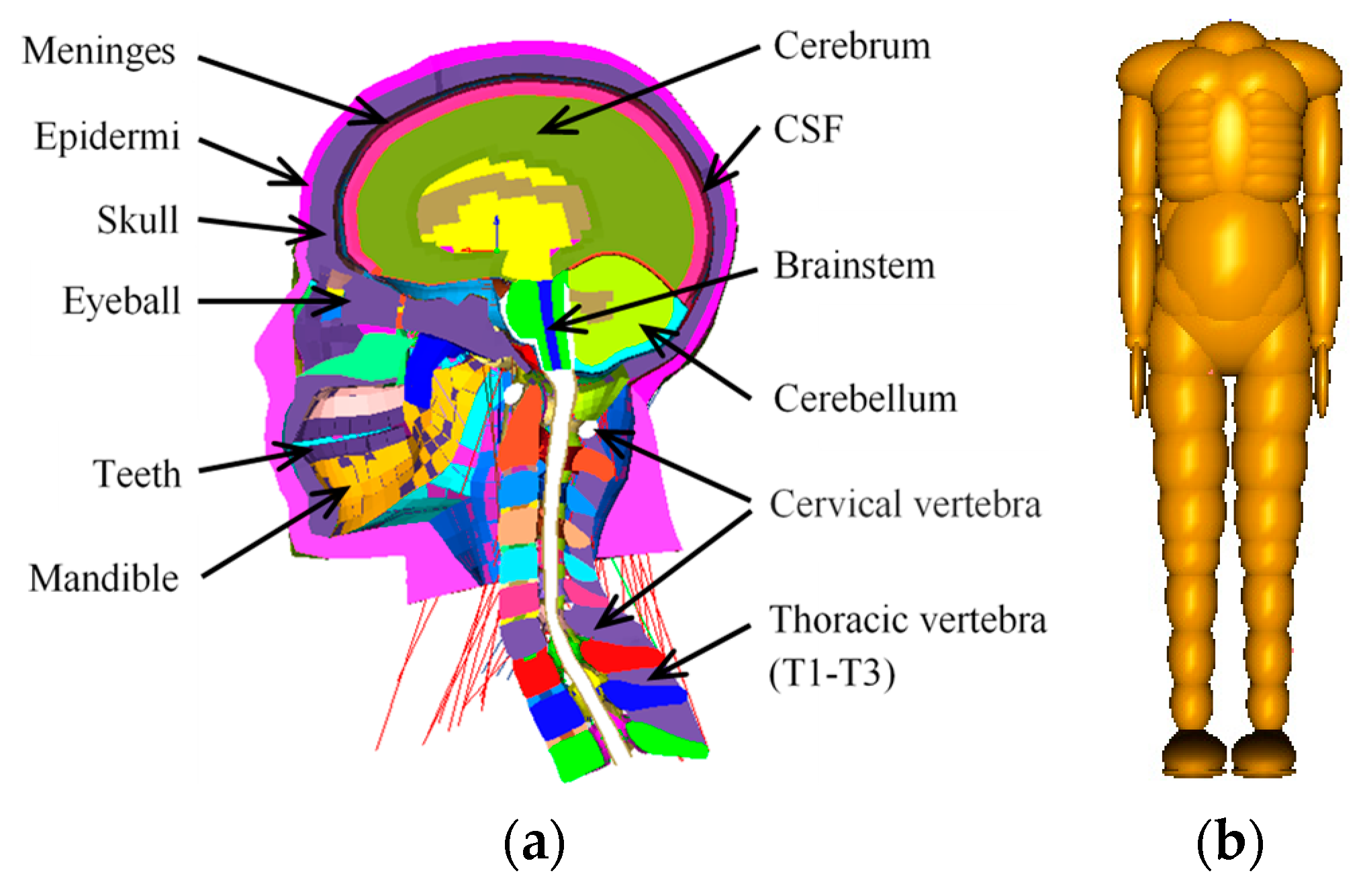
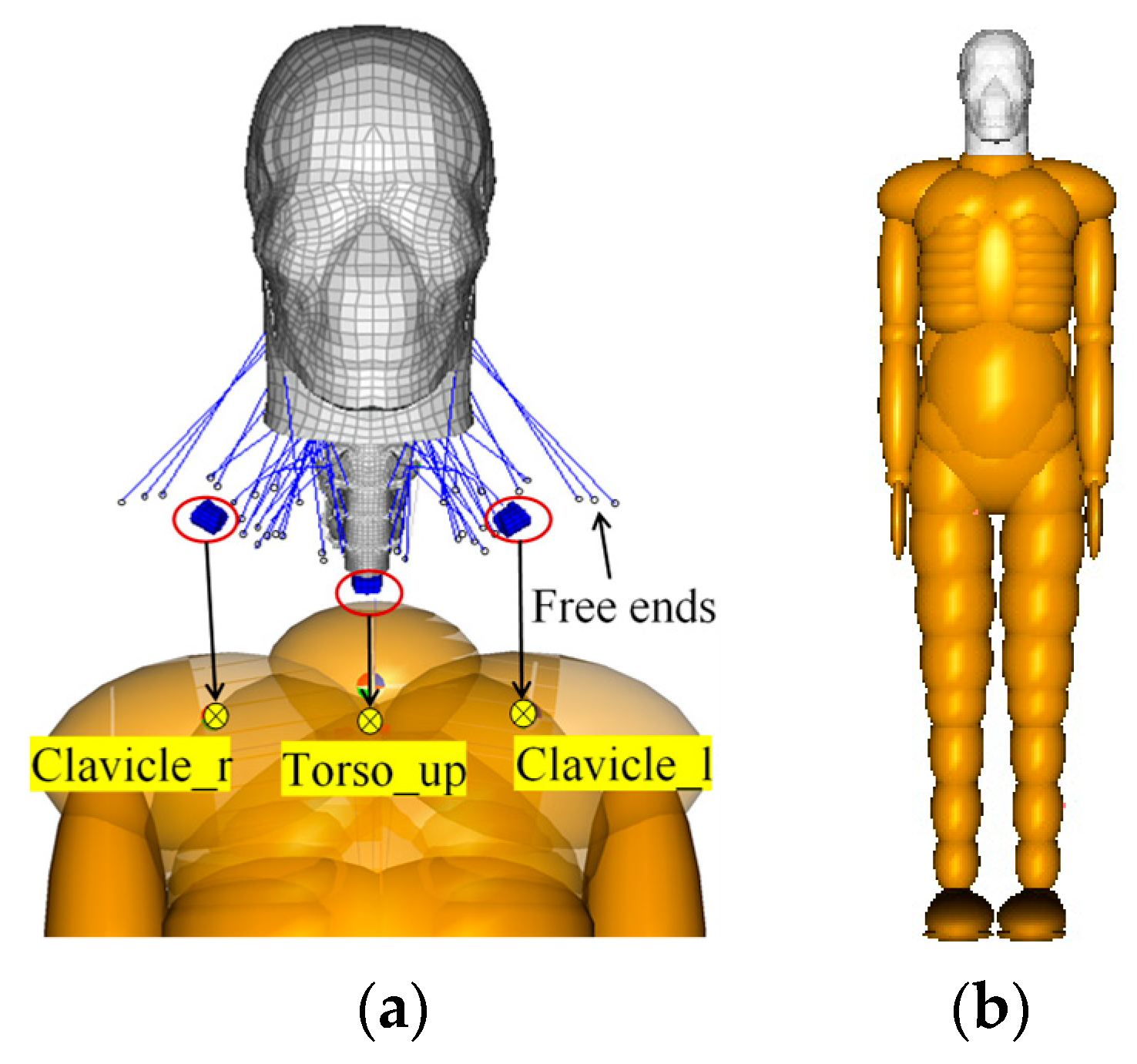

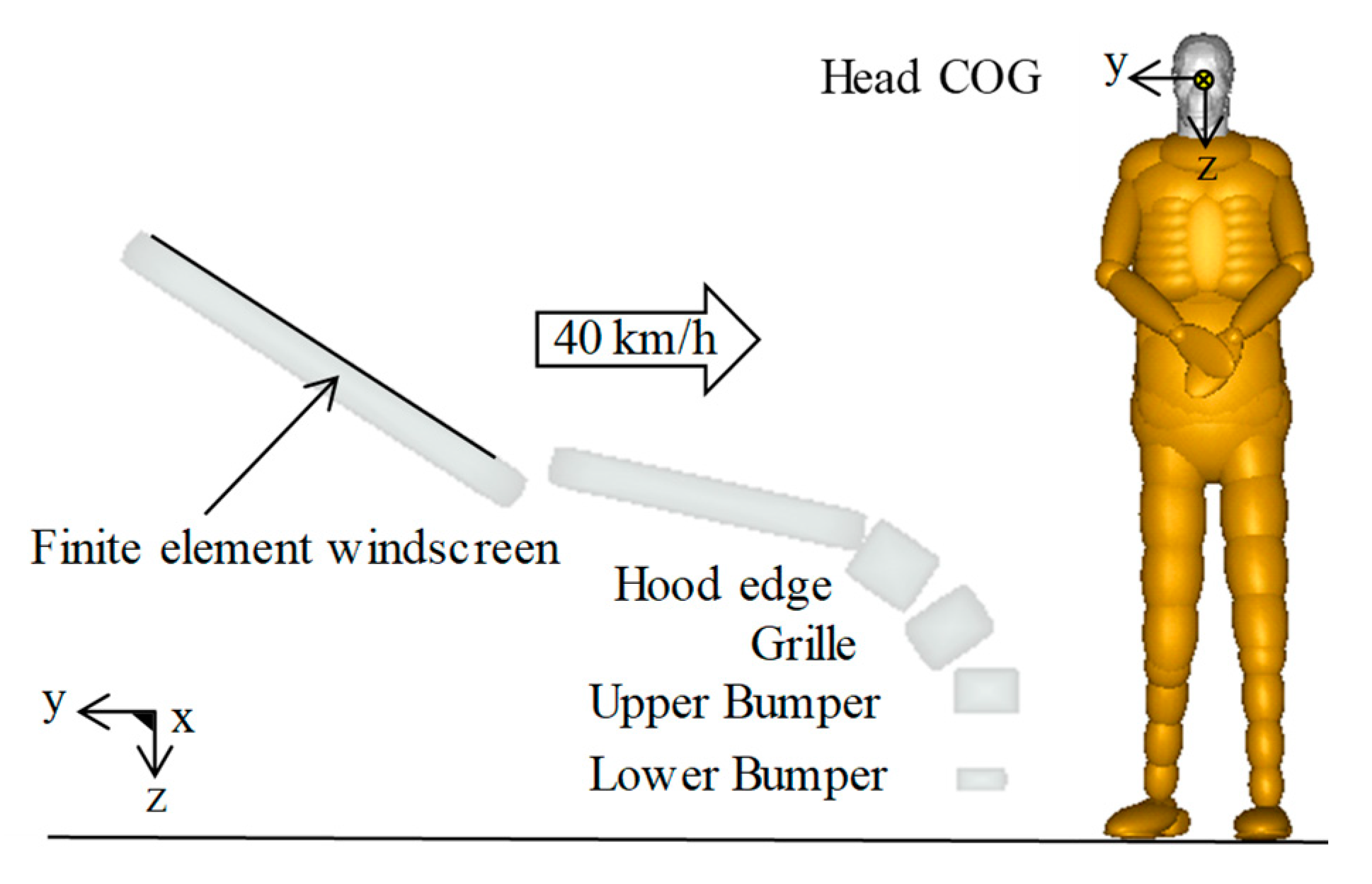



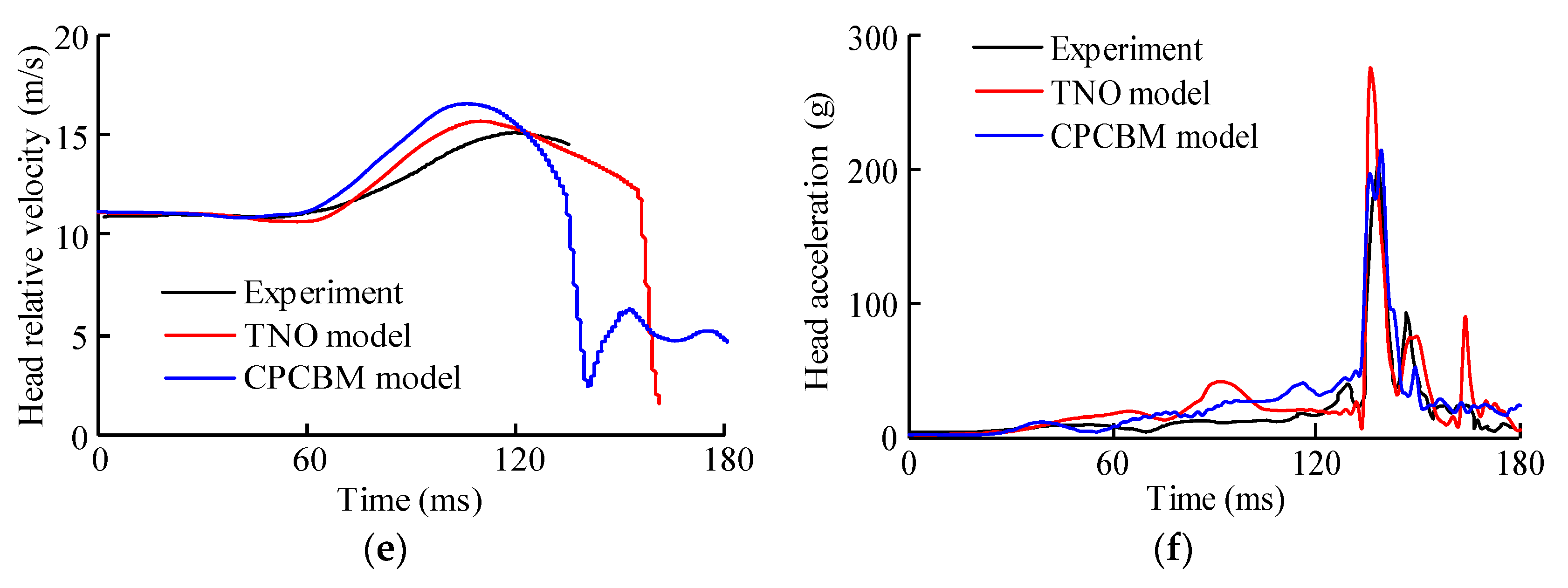



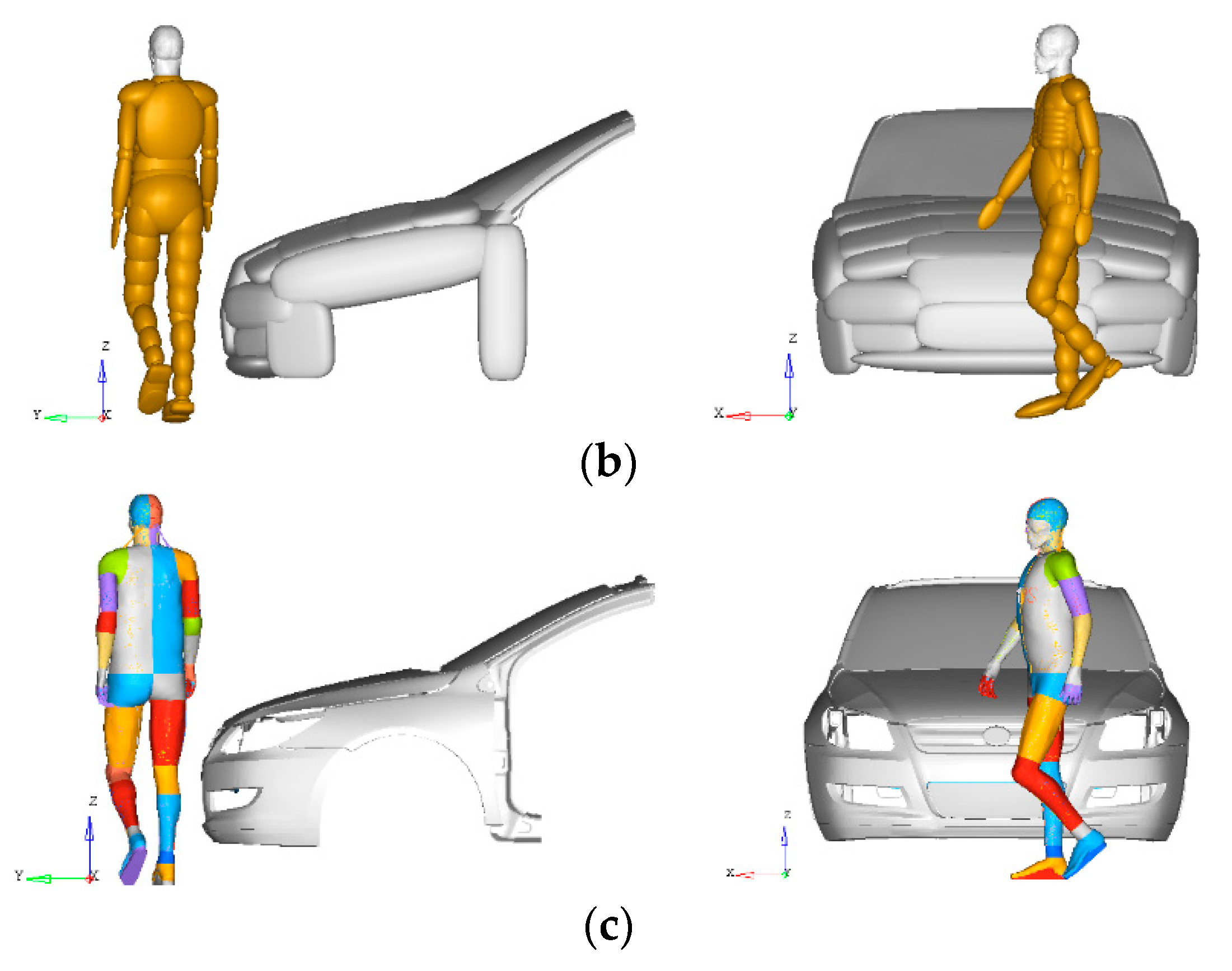
| Test No. | Age | Gender | Height (mm) | Weight (kg) | Cause of Death |
|---|---|---|---|---|---|
| V2370 | 73 | male | 1795 | 72.6 | Heart Failure |
| V2371 | 54 | male | 1870 | 81.6 | Colon Cancer |
| V2374 1 | 67 | male | 1780 | 78 | COPD 2 |
| No. | Body Parameters | Unit | V2370 | TNO2370 | V2371 | TNO2371 | V2374 | TNO2374 |
|---|---|---|---|---|---|---|---|---|
| 1 | Weight | kg | 72.6 | 72.6 | 81.6 | 81.6 | 78.0 | 78.0 |
| 2 | Standing height | mm | 1795.0 | 1795.0 | 1870.0 | 1870.0 | 1780.0 | 1780.0 |
| 3 | Shoulder height 1 | mm | 1555.0 | 1534.2 | 1620.0 | 1611.8 | 1550.0 | 1553.2 |
| 4 | Armpit height | mm | 1400.0 | 1434.1 | 1470.0 | 1498.9 | 1400.0 | 1139.3 |
| 5 | Waist height | mm | 1090.0 | 1128.1 | 1123.0 | 1163.2 | 1070.0 | 1125.6 |
| 6 | Seated height | mm | 957.2 | 949.8 | 1037.2 | 1029.5 | 970.0 | 964.4 |
| 7 | Head length | mm | 185.0 | 185.6 | 205.0 | 195.6 | 198.0 | 181.1 |
| 8 | Head breadth | mm | 161.0 | 156.6 | 157.0 | 153.4 | 158.0 | 154.2 |
| 9 | Head to chin height 1 | mm | 208.5 | 226.9 | 238.5 | 237.4 | 228.0 | 225.9 |
| 10 | Neck circumference | mm | 452.0 | 408.2 | 352.0 | 395.6 | 445.0 | 398.6 |
| 11 | Shoulder breadth | mm | 393.0 | 389.5 | 404.0 | 403.5 | 381.0 | 367.3 |
| 12 | Chest depth | mm | 234.0 | 243.9 | 208.0 | 218.6 | 225.0 | 249.6 |
| 13 | Chest breadth | mm | 321.0 | 316.8 | 330.0 | 341.7 | 293.0 | 298.4 |
| 14 | Waist depth | mm | 180.0 | 179.8 | 190.0 | 201.1 | 190.0 | 199.2 |
| 15 | Waist breadth | mm | 313.0 | 296.6 | 360.0 | 348.8 | 321.6 | 298.3 |
| 16 | Buttock depth | mm | 228.9 | 214.5 | 237.2 | 232.2 | 240.5 | 237.9 |
| 17 | Hip breadth, standing 1 | mm | 345.5 | 339.0 | 345.5 | 368.4 | 310.0 | 328.8 |
| 18 | Shoulder to elbow length | mm | 390.0 | 388.2 | 370.0 | 356.2 | 355.0 | 356.7 |
| 19 | Forearm-hand length | mm | 487.0 | 463.2 | 500.0 | 488.7 | 451.0 | 446.3 |
| 20 | Biceps circumference | mm | 247.0 | 301.4 | 265.0 | 282.6 | 275.0 | 301.4 |
| 21 | Elbow circumference | mm | 239.0 | 219.8 | 254.0 | 250.6 | 258.0 | 219.8 |
| 22 | Forearm circumference | mm | 226.0 | 229.2 | 233.0 | 241.4 | 210.7 | 232.3 |
| 23 | Wrist circumference | mm | 165.0 | 148.2 | 175.0 | 167.8 | 165.0 | 144.4 |
| 24 | Knee height, seated | mm | 585.0 | 569.8 | 570.0 | 522.7 | 565.0 | 553.8 |
| 25 | Thigh circumference | mm | 499.0 | 414.5 | 530.0 | 496.1 | 510.0 | 496.1 |
| 26 | Upper leg circumference | mm | 395.0 | 376.8 | 362.0 | 401.9 | 415.0 | 414.5 |
| 27 | Knee circumference | mm | 349.0 | 332.4 | 380.0 | 376.8 | 386.0 | 345.4 |
| 28 | Calf circumference | mm | 334.0 | 314.3 | 305.0 | 332.8 | 327.0 | 364.2 |
| 29 | Ankle circumference | mm | 190.0 | 257.5 | 245.0 | 282.6 | 238.0 | 282.6 |
| 30 | Ankle height, outside | mm | 92.0 | 102.3 | 90.0 | 101.6 | 88.0 | 97.6 |
| 31 | Foot breadth | mm | 90.0 | 99.8 | 87.0 | 108.2 | 86.0 | 102.9 |
| 32 | Foot length | mm | 238.0 | 241.5 | 238.0 | 254.4 | 198.0 | 217.7 |
| 33 | Hand breadth 1 | mm | 88.6 | 89.5 | 88.6 | 93.6 | 89.1 | 96.6 |
| 34 | Hand length 1 | mm | 192.1 | 187.5 | 192.1 | 188.6 | 191.6 | 182.3 |
| 35 | Hand depth 1 | mm | 27.4 | 28.1 | 27.4 | 30.4 | 27.6 | 30.3 |
| Signal | Test V2370 | Test V2371 | Test V2374 | |||
|---|---|---|---|---|---|---|
| TNO & Test | CPCBM & Test | TNO & Test | CPCBM & Test | TNO & Test | CPCBM & Test | |
| Displacement-X | 0.388 | 0.397 | 0.479 | 0.507 | 0.244 | 0.297 |
| Displacement-Y | 0.977 | 0.998 | 0.973 | 0.968 | 0.989 | 0.997 |
| Displacement-Z | 0.996 | 0.965 | 0.956 | 0.979 | 0.990 | 0.999 |
| Resultant relative velocity | 0.932 | 0.840 | 0.921 | 0.924 | 0.821 | 0.808 |
| Resultant acceleration | 0.739 | 0.759 | 0.780 | 0.825 | 0.651 | 0.717 |
| Model Type | Impact Duration | Calculation Time | Solver |
|---|---|---|---|
| Full-scale TNO model | 240 ms | 1 min | MADYMO |
| Full-scale THUMS model | 240 ms | 42 h | LS-DYNA |
| CPCBM | 240 ms | 7.5 h | LS-DYNA & MADYMO |
| Parameter | V2370 | V2371 | V2374 | Mean ± Standard | THUMS Model |
|---|---|---|---|---|---|
| Weight (kg) | 72.6 | 81.6 | 78 | 77.4 ± 3.7 | 77 |
| Height (cm) | 179.5 | 187.0 | 187.0 | 181.5 ± 3.9 | 175 |
© 2020 by the authors. Licensee MDPI, Basel, Switzerland. This article is an open access article distributed under the terms and conditions of the Creative Commons Attribution (CC BY) license (http://creativecommons.org/licenses/by/4.0/).
Share and Cite
Yu, C.; Wang, F.; Wang, B.; Li, G.; Li, F. A Computational Biomechanics Human Body Model Coupling Finite Element and Multibody Segments for Assessment of Head/Brain Injuries in Car-To-Pedestrian Collisions. Int. J. Environ. Res. Public Health 2020, 17, 492. https://doi.org/10.3390/ijerph17020492
Yu C, Wang F, Wang B, Li G, Li F. A Computational Biomechanics Human Body Model Coupling Finite Element and Multibody Segments for Assessment of Head/Brain Injuries in Car-To-Pedestrian Collisions. International Journal of Environmental Research and Public Health. 2020; 17(2):492. https://doi.org/10.3390/ijerph17020492
Chicago/Turabian StyleYu, Chao, Fang Wang, Bingyu Wang, Guibing Li, and Fan Li. 2020. "A Computational Biomechanics Human Body Model Coupling Finite Element and Multibody Segments for Assessment of Head/Brain Injuries in Car-To-Pedestrian Collisions" International Journal of Environmental Research and Public Health 17, no. 2: 492. https://doi.org/10.3390/ijerph17020492
APA StyleYu, C., Wang, F., Wang, B., Li, G., & Li, F. (2020). A Computational Biomechanics Human Body Model Coupling Finite Element and Multibody Segments for Assessment of Head/Brain Injuries in Car-To-Pedestrian Collisions. International Journal of Environmental Research and Public Health, 17(2), 492. https://doi.org/10.3390/ijerph17020492




